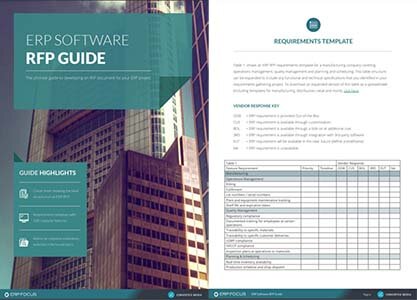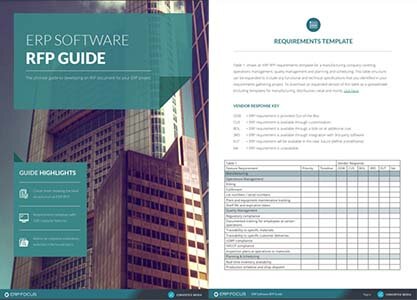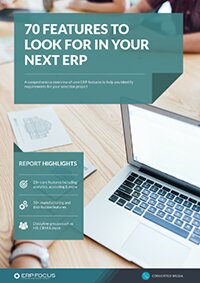A complete ERP RFP template & guide (includes free template)
Your organization needs a new ERP. How do you go about finding the right solution?
Sending out an RFP (request for proposal) is a great way to gather more information on potential vendors and narrow down your list to two or three you'd like to demo.
Given that 60% of ERP projects fail, getting the selection process right from the start is crucial. That's where your RFP for ERP becomes invaluable. A well-crafted ERP proposal helps prevent costly mistakes and sets the foundation for success.
The quality of your ERP RFP and the extensiveness of your requirements-gathering process will naturally influence the quality of responses and can make the difference between a successful ERP selection and a wasted investment.
In this guide, we will delve into what makes a good ERP RFP, what details you need to ask for, provide a sample ERP template, and how to whittle down the options to the best fit for your organization.
What you'll learn about ERP RFPs:
- The difference between RFPs, RFIs, and RFQs
- Gathering your ERP requirements
- Structuring your ERP RFP for the best response
- A customizable ERP RFP template
- Evaluating your RFP responses and considering further steps
RFIs vs RFPs vs RFQs - what's the difference?
Your future ERP RFP process is littered with three-letter acronyms. It's worth clarifying these before we start, to avoid confusion further down the line.
If this is your first selection project, you might be unclear about what each one does and when to deploy them.
You can think of these three requests as a decision-making funnel through which you can eliminate vendors that are not a good fit and get a shortlist of those that offer the best solutions and services for your organization:
- RFI - Request for Information: An ERP RFI can be sent to many vendors, providing broad details on their offerings, values, accreditations, and experience. Once you receive these, you can start eliminating options that don’t seem like a good fit before moving to the next stage.
- RFP - Request for Proposal: With your shortlist ready, it's time to dive deeper. Use the RFP to outline your requirements and key questions. The best responses will show a strong understanding of your needs and proven experience with your must-haves.
- RFQ - Request for Quote: Finally, an RFQ is issued to vendors who meet your initial criteria, requesting a detailed proposal that includes a cost breakdown, service level agreements (SLAs), implementation timelines, and terms. It's the last step before final negotiations.
Gathering your ERP requirements
A successful RFP for ERP starts with understanding and documenting your organization's ERP requirements. This is fundamental to getting your RFP right, and ultimately to the success of the final implementation.
Start by evaluating your current business processes and identifying where changes need to happen. Outline the specific pain points that need addressing and define measurable goals, ideally with quantifiable benefits.
"Poorly executed requirements gathering can be devastating not only to the initial ERP investment costs but also to the operational efficiency of the organization post-implementation"
Wherever possible, those benefits should have a monetary value, although this is not always easy to achieve. Poorly executed requirements gathering can be devastating not only to the initial ERP investment costs but also to the operational efficiency of the organization post-implementation.
Here’s a structured approach to gathering ERP requirements that will form the foundation for your ERP RFP:
1. Back to basics - what is your business strategy?
Revisit your core business goals and align your ERP requirements with them. Ask yourself:
- Are there gaps in your customer relationship management (CRM) or supply chain management (SCM)?
- How could new ERP modules help address these gaps?
- What measurable benefits would you expect from such improvements?
Focus on must-have features versus nice-to-have additions, keeping your business objectives in mind.
2. Survey key stakeholders
Are you giving your suppliers the information they need in a timely manner? What about your customers? Is your finance team pulling their hair out at month's end? Do other business units have multiple systems and offline spreadsheets to manage in order to pull reports or perform processes?
Canvas team members from around the business to identify internal pain points and learn which supplier and customer requirements you could meet more effectively.
Use our ERP requirements template to identify and prioritize your needs for new software
Again, put these requirements into ‘must-haves’ and ‘nice-to-haves’ with measurable goals so that success can be tracked and proven later.
3. Finalize and agree on requirements with all stakeholders
ERP might have started life as a manufacturing and financial operations tool, but your sales team, marketing team, and HR teams can also provide valuable insight. You may well have ERP users in every business unit - make sure you don’t miss an opportunity or a potential pitfall by excluding a key stakeholder.
This is also the time to get the requirements in priority order and, once again, look back to check business strategy alignment for each one.
Structuring your ERP RFP for the best response
When writing an ERP request for proposal, clarity and thoroughness are key. Vendors need a clear understanding of your current software environment, implementation timeline, internal support capabilities, and the problems you aim to solve.
Producing a document with a solid introduction to your business needs, operations, pain points, and ERP ambitions will help put your requirements into context. This might lead to unexpected solutions and benefits that you hadn’t thought of or included in your RFP template.
Below is a guide to structuring your RFP to maximize vendor responses and ultimately make a more informed decision.
Section 1: Background information
Provide a concise overview of your organization, including:
- Company size
- Number of ERP users
- Satellite offices
- Expected growth
- ERP system objectives
Section 2: Project scope
Clearly outline the responsibilities expected of the vendor. Include:
- Implementation timelines from ERP RFP send-out to go-live
- Key milestones
- The anticipated project budget
Section 3: Requirements list
Offer a detailed breakdown of your ERP functional and technical requirements. Organize these by business unit or department and request that vendors explain how their solution will meet each requirement, indicating whether it’s out-of-the-box or requires customization.
Section 4: Vendor qualifications
Ask vendors to provide:
- Relevant experience in your industry
- Client references
- Accreditations, certifications and awards
- Proof of financial stability and long-term viability
Section 5: Budget and pricing
Request a detailed cost breakdown, covering a timeframe of 3 to 6 years. Include a deadline for pricing validity to ensure up-to-date quotes.
Section 6: Contractual terms
Ask vendors to submit their standard contractual terms and any adjustments they foresee for your project.
Section 7: Evaluation criteria
Explain how vendors will be evaluated, including:
- Scoring metrics (e.g., ability to meet requirements, cost, timeline)
- Award timelines
- Contact information for key personnel involved in the decision-making process
A customizable ERP RFP template
Here is a simple ERP RFP template that can be adapted for your project:
| Section | What to include |
|---|---|
| Background information | Company overview, operations, user numbers, growth forecast, system objectives |
| Project scope |
Responsibilities, project timeline, expected outcomes. |
| Requirements list |
Functional and technical needs, by department |
| Vendor qualifications and references |
Industry experience, references, certifications |
| Budget and pricing | Detailed cost breakdown for 3-6 years |
| Contractual terms and conditions | Standard and project-specific terms |
| Evaluation criteria | Scoring process, timelines and award criteria |
| Contacts | Key contacts for RFP-related inquiries |
For a more detailed ERP RFP template, check out our ERP RFP guide
Evaluating your RFP responses and considering further steps
Having a process in place for proposal evaluation is essential in ensuring that you select an ERP that meets your key requirements.
You may want to consider scoring each vendor against their ability to meet each of the requirements you outlined in your RFP, perhaps on a scale of one to five.
Here are the factors to consider whilst doing so, to avoid the process descending into chaos.
- Rank vendors based on key criteria: Immediately discard any vendor that cannot meet your top priorities. For the remaining candidates, use a scoring system (e.g., 1-5) to rank their ability to meet your key requirements.
- Compare support options: Which vendors can give you the ongoing support that you need? How do their SLAs compare, and will you be paying extra for the vendor support you need in the future?
- Arrange demos for the remaining contenders: Schedule demos with shortlisted vendors to explore functionality and address key questions, such as their experience with similar clients and ability to complete your project.
- Request final pricing: After the demos, request a detailed pricing proposal from each vendor. This should include any customization costs, implementation fees, and ongoing support charges.
Our guide to mastering ERP demos in five easy steps goes into more detail about the demo process
Conclusion
Creating the perfect ERP RFP takes time and patience, but the benefits are clear (and the potential losses can far outweigh the time spent).
A well-thought-out RFP is crucial to a solid decision for your business. We hope these tools and steps help you find the right ERP solution for you and avoid some pitfalls buyers can find along the way.
Free white paper

ERP Software RFP Guide & Template
The comprehensive guide to developing an RFP document for your ERP project

Featured white papers
Related articles
-

ERP for Food Distributors: Key Functionality
In a modern world where products are tailored to consumers, why should ERP for food distributors ...
-

Secret KPI: Why Your ERP Implementation Team Matters More Than Software
Learn how Godlan ensures successful ERP implementation for manufacturers with proven strategies &...
-

Top 10 ERP selection criteria (including checklist)
The most important ERP selection criteria you should keep in mind during your selection process.


